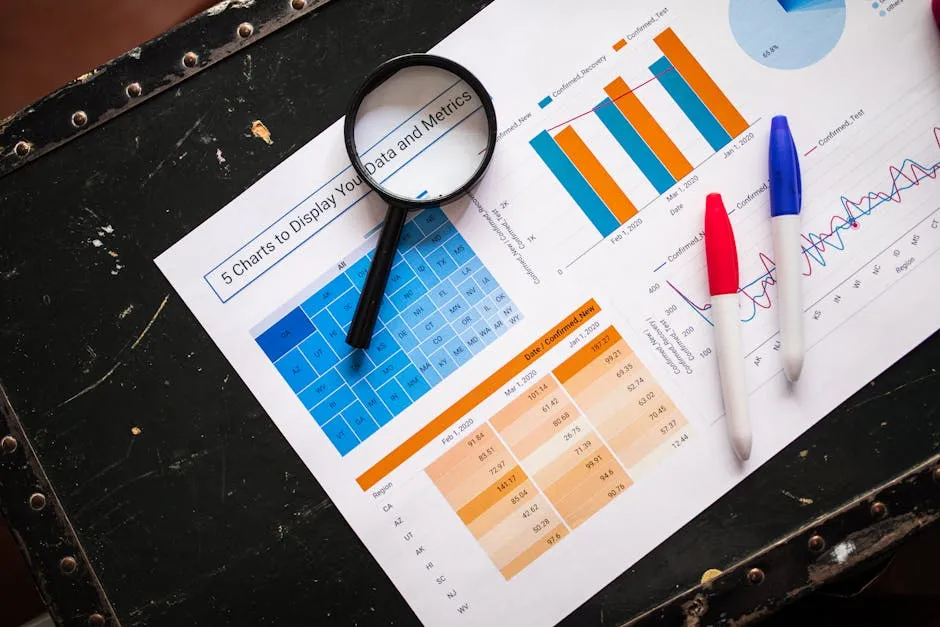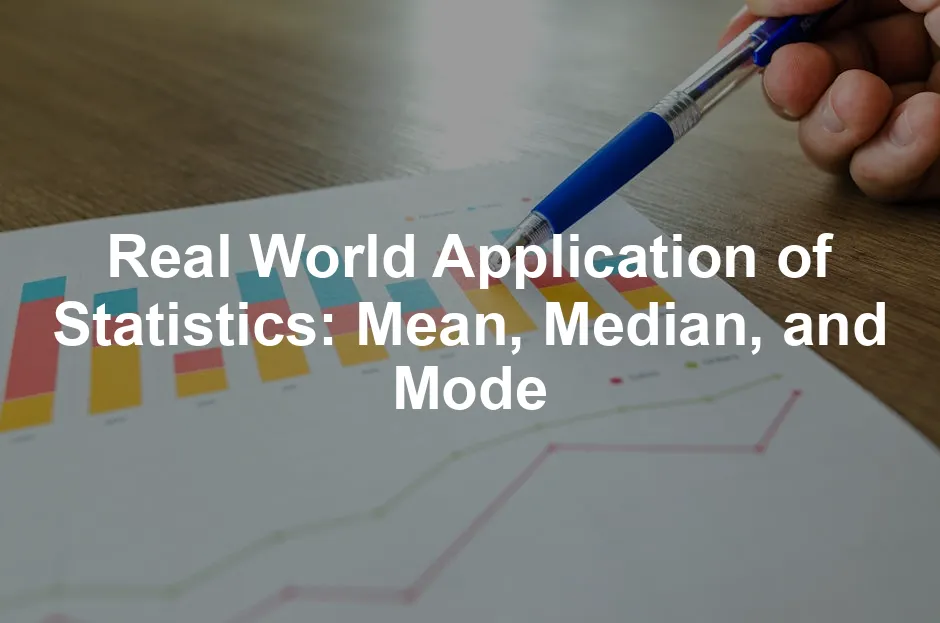Introduction
Statistics is like a magic wand for understanding data. It helps us make sense of the numbers swirling around us every day. Whether you’re a business tycoon or a curious student, statistics helps you interpret data and draw meaningful conclusions. Among the many statistical concepts, mean, median, and mode are the holy trinity of measures of central tendency. They provide shortcuts to finding a typical value within a dataset, saving us from drowning in a sea of numbers.
The mean is the average value, calculated by summing all values and dividing by the count. The median is the middle value when data is sorted, providing a better picture when outliers are present. Lastly, the mode stands tall as the most frequently appearing value in the dataset, revealing trends we might overlook.
This article aims to reveal the real-world applications of mean, median, and mode across various fields. By exploring these statistical measures, you’ll see how they guide decisions and strategies in healthcare, education, business, and more. So, buckle up! It’s time to see how these three little measures pack a mighty punch in the big world of data analysis.

To dive deeper into the foundational concepts of statistics, check out this introduction to statistical learning with Python.
Understanding Mean, Median, and Mode
Definition of Mean, Median, and Mode
Mean: Calculating the mean is a straightforward task. Simply add all the values together and divide by the number of values. For example, if you have test scores of 70, 80, and 90, the mean would be (70 + 80 + 90) / 3 = 80. The mean is vital because it provides a central point around which the data clusters. However, be cautious! Outliers can skew the mean dramatically, making it less representative of the dataset.
To understand these concepts more deeply, consider reading “Naked Statistics: Stripping the Dread from the Data” by Charles Wheelan. It’s a fantastic read that demystifies statistics and makes it approachable for everyone!
Median: To find the median, you need to sort your data. For a set of values like 3, 5, 7, 9, the median is 5 — the middle value. When dealing with an even number of observations, average the two middle numbers. The median is particularly handy when your data has outliers. For instance, in a salary dataset where one person earns a million dollars, the median salary will better represent the typical employee’s earnings than the mean, which could be inflated.
For those who want to dive deeper into the world of statistics, consider picking up “Statistics for Dummies” by Deborah J. Rumsey. It’s a friendly guide that makes statistical concepts easy to grasp!
Mode: The mode is the most frequent value in a dataset. If you have a dataset of shoe sizes: 7, 8, 8, 9, 10, the mode is 8 because it appears most often. The mode is particularly useful in categorical data where we want to identify the most popular category. For example, if a clothing store finds that size medium is sold more than any other, they will stock more of that size based on the mode.
These three measures—mean, median, and mode—are the backbone of statistical analysis. They serve different purposes and provide unique insights, making them indispensable tools in various fields. Understanding these concepts empowers you to make data-driven decisions that can have a lasting impact!

For more insights on how these measures apply to salary distributions, you can read about median salary trends in Poland.
Characteristics of Each Measure
Statistics can be a bit like a three-legged stool, with each measure of central tendency bringing its own strengths and weaknesses. Understanding these can help you choose the right measure for your data analysis needs.
Mean: The mean is often the go-to measure because it provides an average that’s easy to grasp. However, it has a significant flaw: outliers can skew it. Picture a small town where everyone earns a modest salary, but one tech billionaire moves in. Suddenly, the mean income skyrockets, leaving the average worker scratching their head. When analyzing data, especially with extreme values, take the mean with a grain of salt.
Median: Here comes the median, the unsung hero of statistics. It cuts through the noise of outliers to give you a better representation of a dataset’s center. Imagine a class where most students score around 75, but one genius aces the test with a perfect 100. The median score helps depict the typical performance without being thrown off by that one standout. It’s particularly useful in skewed distributions, where the mean might mislead you.
Mode: Finally, we have the mode, the most frequently occurring value. This measure shines when it comes to categorical data. Want to know the most popular pizza topping among your friends? Just find the mode! If everyone loves pepperoni, that’s your answer. The mode can also tell you about trends, like which shoe sizes fly off the shelves in a store. For marketers and product developers, it’s a treasure trove of insights.
In summary, while the mean can be affected by outliers, the median provides stability in skewed distributions, and the mode highlights popularity. Each measure has its place in the analytical toolbox, ensuring that you can paint a complete picture of your data.

Business and Marketing
In the fast-paced world of business and marketing, understanding your numbers is crucial. Statistics provide the keys to unlocking customer insights and enhancing strategic decision-making. Let’s break down how mean, median, and mode play vital roles in this arena.
Mean: The mean is a powerful tool for analyzing average sales or revenue. Imagine you’re a business owner looking to boost profits. By calculating the mean sales over several months, you can identify trends and make informed decisions. For instance, if your average monthly sales are steadily increasing, that’s a green light to ramp up production or marketing efforts. Conversely, a dip in the mean could signal a need to reassess your strategies.
If you’re looking to refine your data analysis skills, consider “How to Measure Anything: Finding the Value of ‘Intangibles’ in Business” by Douglas W. Hubbard. This book provides insights into how to quantify seemingly immeasurable aspects of your business.
Median: The median is particularly handy for analyzing income distributions. Suppose you’re targeting a specific customer segment. A median income analysis can help you understand your audience better. If the median income of your target market is significantly lower than the mean, this indicates that a few high earners could skew your perception of the market. By focusing on the median, you can tailor your products or services to meet the needs of the majority.
Mode: When it comes to determining the most popular products or services, the mode is your best friend. By analyzing sales data, you can quickly identify which items fly off the shelves. For instance, if your online store sees that a particular gadget is sold more than any other, that’s the mode in action! This information can guide your inventory decisions, ensuring you stock up on what customers really want.
In summary, mean, median, and mode are indispensable in business and marketing. They help you decipher customer behavior, improve product offerings, and ultimately drive growth.

Real Estate
The real estate market thrives on statistics, and mean, median, and mode are essential for navigating this complex landscape. These measures help buyers, sellers, and agents make informed decisions.
Mean: In real estate, calculating the mean price of properties can provide insights into market trends. For instance, if you’re a seller, knowing the average price of similar homes in your neighborhood can help you set a competitive listing price. If the mean price is rising, it might be a good time to sell. Conversely, if it’s dropping, you may want to hold off or consider pricing strategies.
For those interested in real estate analytics, consider reading “The Data Warehouse Toolkit: The Definitive Guide to Dimensional Modeling” by Ralph Kimball. This book provides foundational knowledge for understanding data architecture in real estate.
Median: The median is often the hero in real estate statistics. It gives a clearer picture of typical housing costs, especially in markets with extreme values. For example, if a few luxury homes skew the mean price upward, the median will still represent the price most homebuyers can expect. This helps buyers avoid overpaying and gives sellers a realistic view of what to expect in their sales.
Mode: The mode shines when identifying the most common features in homes. If agents find that the mode for the number of bedrooms in sold properties is three, they can advise builders to focus on constructing three-bedroom homes. This insight ensures that developers meet market demand and maximize sales potential.
In essence, mean, median, and mode are vital for anyone involved in real estate. They help in assessing property values, guiding buying and selling decisions, and understanding market demands.

Sports Analytics
In the realm of sports, analytics has become a game-changer. Teams and coaches are leveraging statistics to enhance performance and strategy, making mean, median, and mode indispensable.
Mean: The mean is vital for evaluating player performance metrics. For example, if a basketball player scores 20, 25, and 30 points over three games, calculating the mean gives a quick snapshot of their scoring ability—25 points per game. This average helps coaches assess consistency and plan training strategies accordingly.
If you’re serious about sports analytics, consider “The Signal and the Noise: Why So Many Predictions Fail – But Some Don’t” by Nate Silver. This book dives into the art of prediction and how data impacts decision-making in sports.
Median: The median serves as an essential measure when assessing typical performance levels. In a season where one player has an extraordinary game, skewing the mean, the median score provides a more reliable view of what a player usually achieves. This helps teams understand performance trends without being misled by outliers.
Mode: Finally, the mode plays a crucial role in identifying the most common scores or outcomes in games. For example, if a certain team frequently wins by a score of 3-1, that’s the mode. This insight can help coaches develop strategies based on historical performance patterns, enhancing game preparation.
In conclusion, mean, median, and mode are integral to sports analytics. They provide clarity on performance metrics, guide strategic decisions, and ultimately contribute to a team’s success on the field.

Human Resources
In the world of Human Resources (HR), statistics play a pivotal role in making informed decisions. Among these, mean, median, and mode help shape compensation strategies and workforce planning.
Mean: When it comes to salaries, HR managers often calculate the mean salary for various positions. This average helps ensure competitive compensation packages. For instance, if the mean salary of software engineers in your company is $90,000, it sets a benchmark. This figure can guide negotiations with prospective hires, ensuring they receive fair compensation that aligns with market standards.
If you’re looking for a solid introduction to statistical methods in the social sciences, check out “Statistical Methods for the Social Sciences” by Alan Agresti. This book covers essential statistical techniques that are crucial for HR analytics.
Median: The median salary provides valuable insights into salary distributions within the organization. It’s particularly useful for identifying pay disparities. For example, if the salaries of employees are $40,000, $50,000, $60,000, and $1,000,000, the median salary would be $60,000. This figure represents the middle ground, showing what a typical employee earns without being skewed by that one high earner. It helps HR ensure equitable pay practices and maintain employee morale.
Mode: The mode identifies the most common job titles or roles within the organization. By analyzing the mode, HR can determine which positions are most frequently filled. For instance, if the mode indicates that the majority of employees are in customer service roles, HR can then tailor recruitment strategies or training programs to support that area. Understanding the mode helps in workforce planning, ensuring that resources are allocated where they are most needed.
In summary, the application of mean, median, and mode in HR not only enhances compensation strategies but also fosters a more equitable workplace. These measures ensure that decisions are data-driven, aligning with industry standards and promoting a satisfied workforce.

Conclusion
Mean, median, and mode are essential tools that hold significance across various fields, providing clarity and insight into data analysis. In healthcare, education, business, and beyond, these measures help professionals make informed decisions based on quantitative evidence.
The mean gives a straightforward average, but it can be skewed by outliers. The median shines bright in situations where extremes distort the picture, offering a reliable measure of central tendency. Meanwhile, the mode reveals the most common values, serving as a guide to trends and preferences.
By applying these statistical measures, individuals and organizations can better understand their data, from salary distributions in HR to average grades in education. Recognizing their importance empowers professionals to develop strategies that are informed and effective.
In both professional and personal contexts, considering mean, median, and mode can lead to smarter choices. So, the next time you find yourself knee-deep in data, remember these three amigos—they’re here to help you make sense of it all!

FAQs
What is the difference between mean, median, and mode?
The mean is the average value of a dataset. You calculate it by adding all numbers together and dividing by the count. The median represents the middle value when data is sorted. It’s crucial when dealing with outliers since it provides a true center. The mode is the most frequently occurring value in a dataset. This measure is particularly useful for categorical data, helping to identify the most common group.
How can outliers affect the mean?
Outliers can significantly skew the mean. Imagine a dataset where most values are around 10, but one value jumps to 100. The mean would be misled upward, suggesting the average is much higher than what most values indicate. In such cases, the median shines through, giving a clearer picture of the dataset’s central tendency without being distorted by extreme values.
Can a dataset have more than one mode?
Yes, a dataset can be unimodal (one mode), bimodal (two modes), or multimodal (multiple modes). For instance, if survey results show preferences for two equally popular products, both products would be considered modes. This characteristic helps capture the diversity within data, allowing better insights, especially in market research.
In what scenarios is the median more useful than the mean?
The median is particularly useful in skewed distributions, like income levels or home prices. For example, if a few high-income earners exist in a community, the mean would not accurately represent the typical income. The median, however, would provide a better sense of what most people earn. Similarly, in real estate, the median home price offers a more accurate benchmark than the mean price, which could be inflated by luxury properties.
How can businesses apply these measures?
Businesses utilize these measures for various applications. In market research, they analyze customer preferences using mode to determine the most popular products. The mean helps assess average sales or revenue, guiding strategic decisions. Meanwhile, the median is valuable for understanding income distributions among customers, which informs pricing strategies and marketing efforts effectively.
Please let us know what you think about our content by leaving a comment down below!
Thank you for reading till here 🙂
All images from Pexels




